-
Posts
818 -
Joined
-
Last visited
Content Type
Profiles
Forums
Gallery
Events
Posts posted by woodrat
-
-
1 hour ago, Louie da fly said:
1. Yes, it's cartoon-like.
2. It might be possible to use shading to make it more naturalistic, as was done in the Middle Ages
1 hour ago, Louie da fly said:3. Given the Mediterranean love of bright plain colours, your version is probably historically correc
Yes, I agree with your first and third option. It is likely that bright primary colours were used (the greeks loved painting up their sculptures) and addition of geometric patterns such as zigzag lines and spirals will help break up the cartoon like appearance.
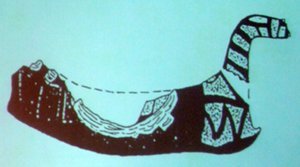 Also the knobs on the head will need to be extended along the beak
Also the knobs on the head will need to be extended along the beak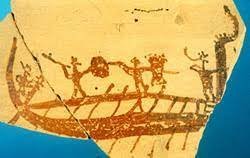

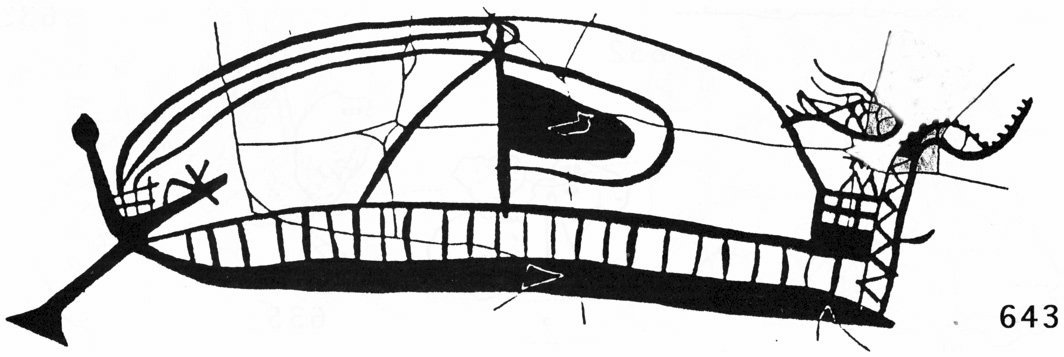
I also plan some oculi even though they are not seen on the pottery images. But I cant imagine any mediterranean sailor going to sea without them! The eyes on the duck are not enough.
Dick
- GrandpaPhil, mtaylor, botra288 and 1 other
-
 4
4
-
I felt the need for some colour so I have painted the Angry Duck. I hope its not too cartoon like. The knobs along the neck and head are seen on several pottery images and may represent att achment points for feather or hair crest. The second crutch for the mast and yard is installed.
Next is the installation of "hogging truss"
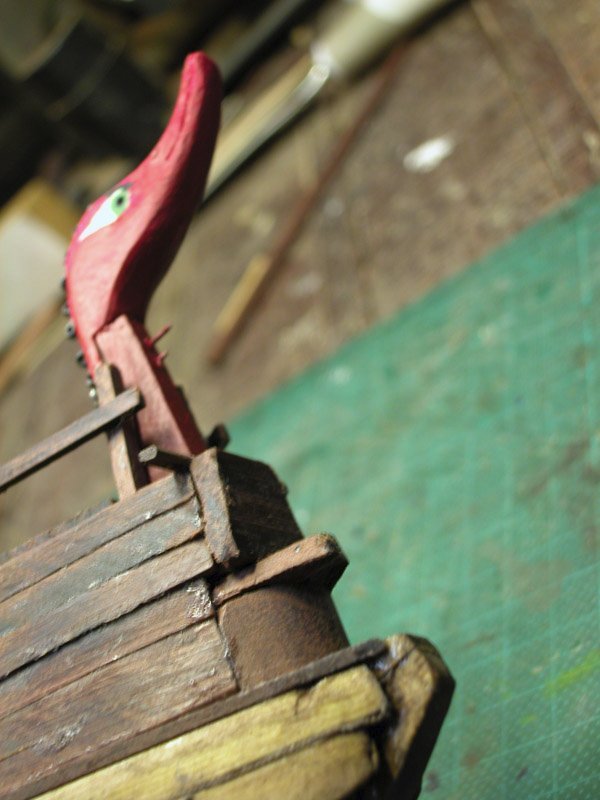
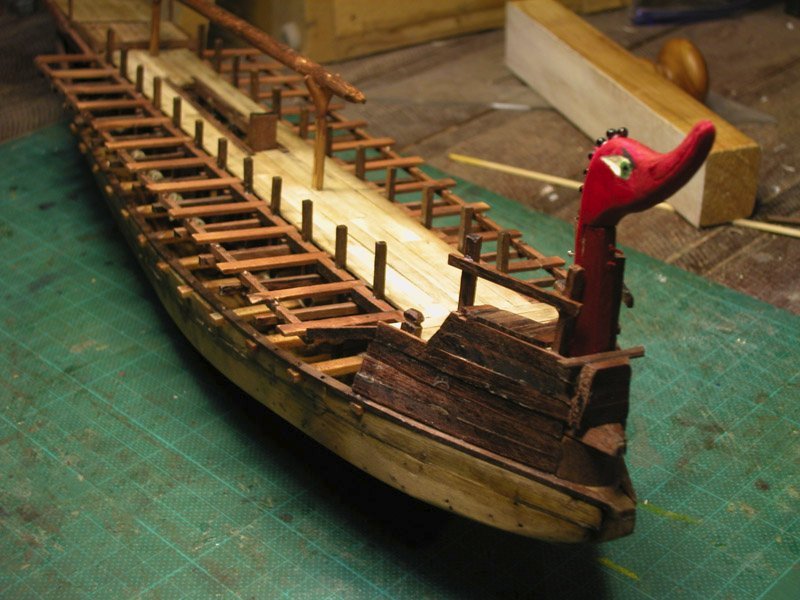
Cheerio
Dick
- botra288, davyboy, Louie da fly and 5 others
-
 8
8
-
There is ample evidence from art of the Old Kingdom of Egypt onwards for hogging trusses. Hogging is the tendency for a boat, when on the crest of a wave with its stern and stem unsupported, to bend in its mid-section. This risks the boat breaking up. In order to prevent this the egyptians looped heavy rope around the stern of the boat, ran the rope over crutches along the centreline of the boat and looped around the stem of the boat. The rope was tensioned with a Spanish windlass. This relieved much stress from the joints of the boat and made it more seaworthy.
As the mycenaean war galley would also have a tendency to hog, it is reasonable to suppose that some form of hogging truss would have been employed on these seagoing vessels. As no art or shipwrecks from the Bronze Age have survived which show a hogging truss, it is a matter of speculation as to how this would have been done. So, let’s try.
In the trieres (trireme) of the Mediterranean of several hundred years later there are references to what were called the hupozomata (hupozoma singular). This term means an undergirding and was meant to longitudinally strengthen the trireme to do much the same job as a hogging truss. There has been much argument in the learned literature as to whether the strengthening rope passed under the keel, around the outside of the hull or along the centreline of hull. Without belabouring you with the arguments, the first option is not likely as the rope would prevent launching.
The present consensus is that hupozomata (and in a trireme there were likely several of these) passed along the centre line of the hull under the main beams and was connected with a bridle of plaited rope (koruphaia) passing around the stern of the vessel. The other end of the hupozoma was attached at the stem somehow or encircled it. Also there was a mechanism (tonoi or entonoi) which allowed tensioning of the hupozomata. We don’t know what this mechanism was but Plato mentions a “spindle” of some kind. As rope changes its length depending on whether it is wet dry, such a mechanism would have to permit adjustment while the vessel is at sea.
To demonstrate how important the hupozomata were, the greeks only applied them to those triremes which were in active service and removed them from inactive triremes. In other words, the triremes were not allowed to go to sea without them installed and tensioned.
To return to our war galley, clearly a much shorter vessel than a trireme, structural integrity was just as important in the Bronze Age but they may used simpler methods. So, I postulate a mechanism intermediate between the simple hogging truss of the egyptians and the complicated hupozomata (for, after all, they were just another way to do a hogging truss) of the age of the trireme.
And I have a cunning plan which cannot fail
Dick
- botra288, mtaylor, Louie da fly and 4 others
-
 7
7
-
Ian, in answer to your question on my mycenaean blog, there is definitely good evidence from the archaeology of mast steps. The following drawing is of the Chretienne A wreck from Madrague de Giens (150 - 100 bce) which shows the mast step on a large block on the keelson . There is an aft facing curved surface and an inclined plane which suggests that the mast is removable Also see Casson "Ships and Seamanship etc" page 208. The slots besdide the mast step may be for a tabernacle.
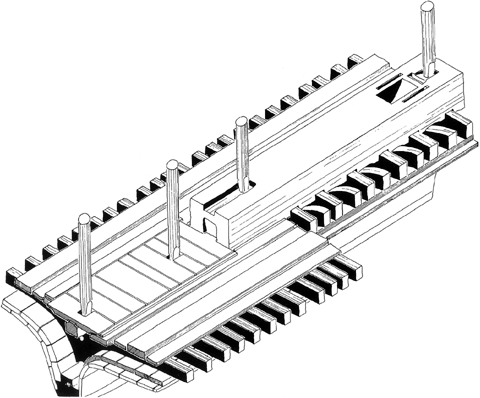
Also see this article on mast step coins:
The International Journal of Nautical Archaeology
(2007)
36
.2: 317–324
doi: 10.1111/j.1095-9270.2006.00132.x
MAST-STEP COINS AMONG THE ROMANS
D. N. CARLSON
Mast-Step Coins among the Romans
Deborah N. Carlson
Nautical Archaeology Program, Department of Anthropology, Texas A&M University, College Station, Texas
77843–4352, USAThe evidence for mast crutches is more iconographic as Louie da Fly has previously shown. I know of no crutches found in ancient wrecks.
Hope this helps a bit
Dick
- mtaylor, GrandpaPhil, botra288 and 3 others
-
 6
6
-
The accommodation for the steersman at the stern is installed. At the forward end, a partial platform behind the stempost allows the head warrior to brutalise the natives but allows him to duck behind a pavise should the natives get too uppity. Note the bird shaped figurehead roughed out. This has been seen on several pottery depictions of these vessels.
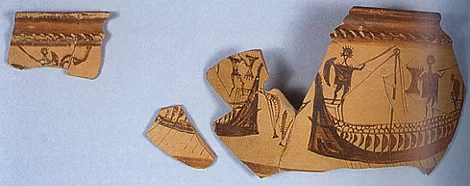
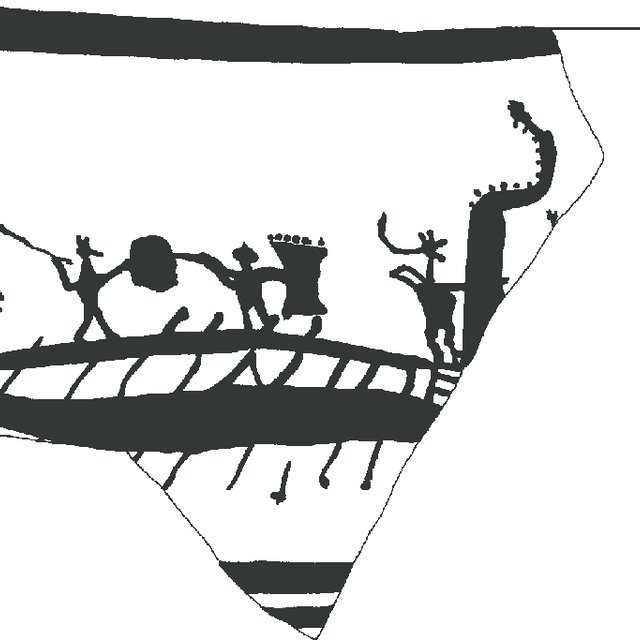
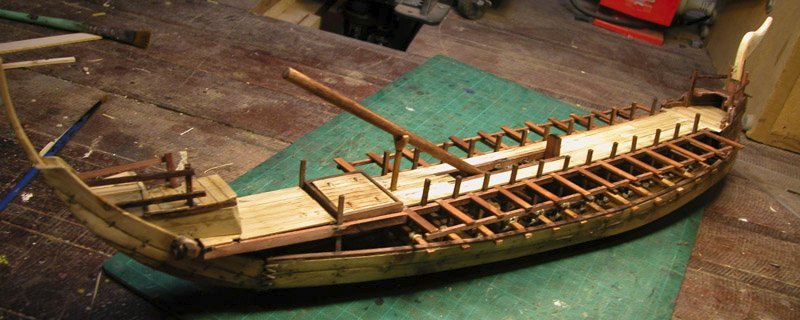
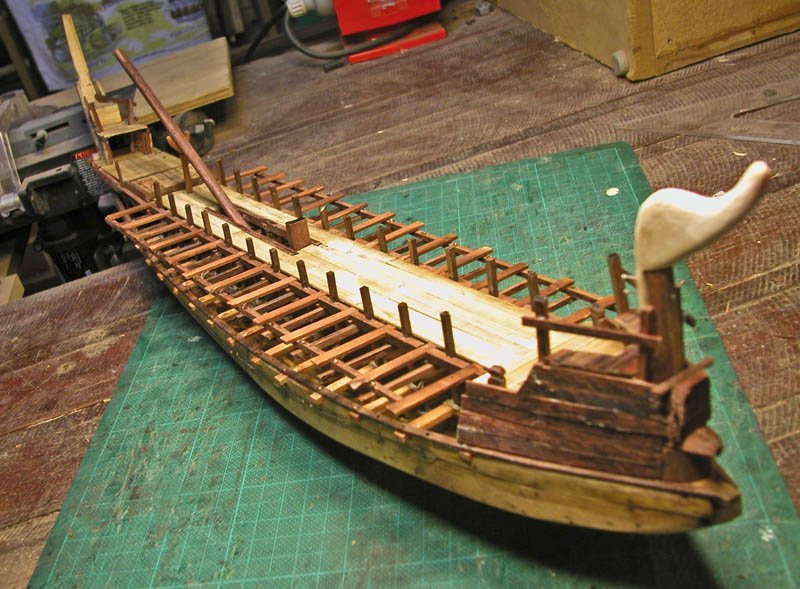
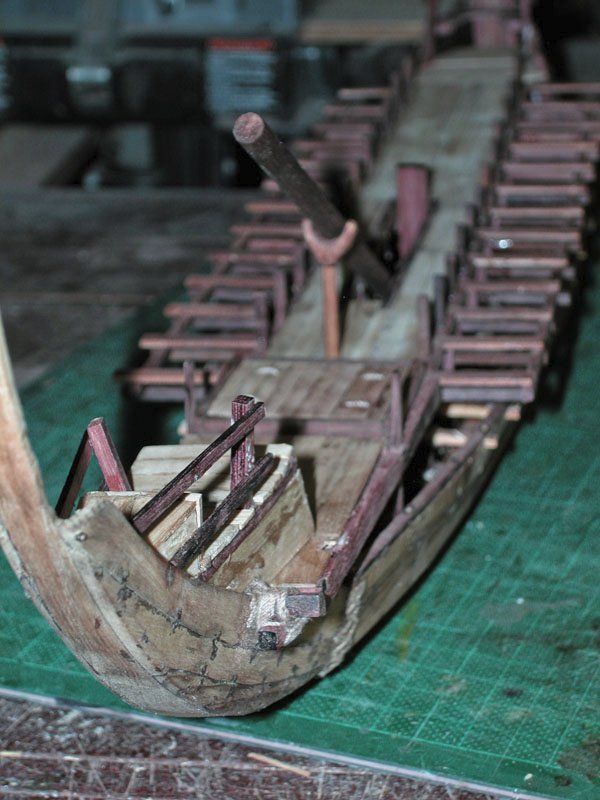
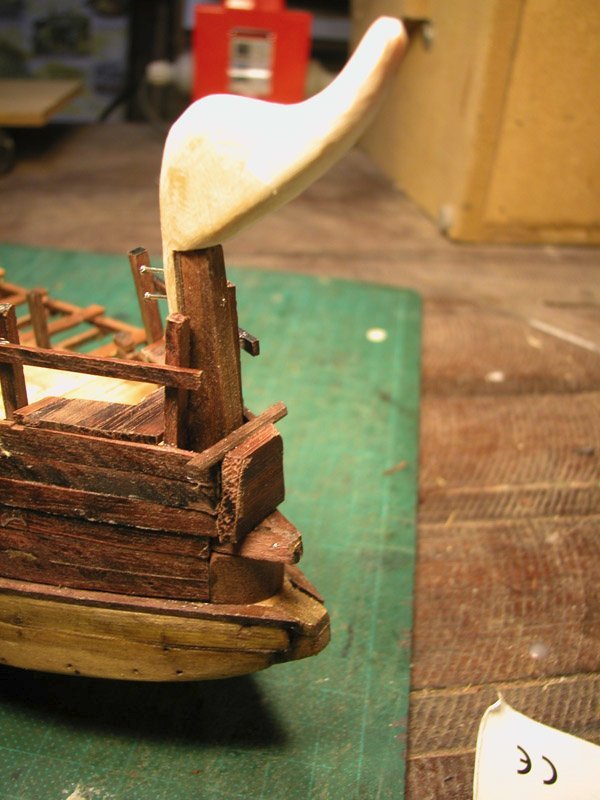
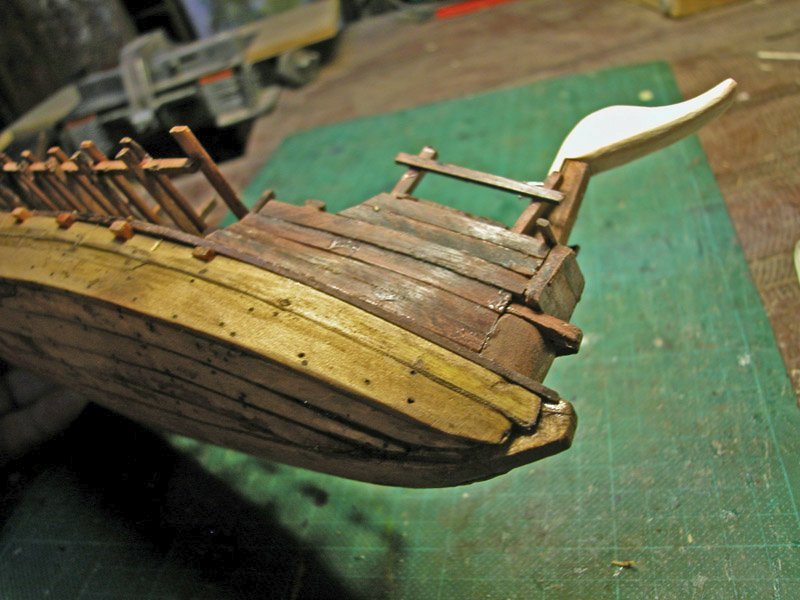
Dick
- mtaylor, Archi, Louie da fly and 10 others
-
 13
13
-
Much to my surprise I seem to have built a forecastle! Once the upper bank of rowers was inserted, the central walkway (or galumphing platfrorm for warriors) was planked. The lines of pilons lining the walkway will be used for the housing of shields. In the after part of the walkway a large compainioway is seen which will give access to the underdeck and to the stern. I need to give some consideration to where water would be stored. Weapons and food could be stored under the central walkway/deck. Would water be carried in amphorae or skins??
As these vessels were not ocean crossing, large amounts of water and food would not have been carried. They would travel along the coast from beach to beach and live off the sea and land, presumably extorting provisions from locals as they went.
When not in use it is likely that the mast and yard were lowered onto the crutch and derigged. The mast and yard would have been lashed along the central walkway until next needed..
Next job is the ox-hide weather-and arrow-shield for the upper bank of rowers
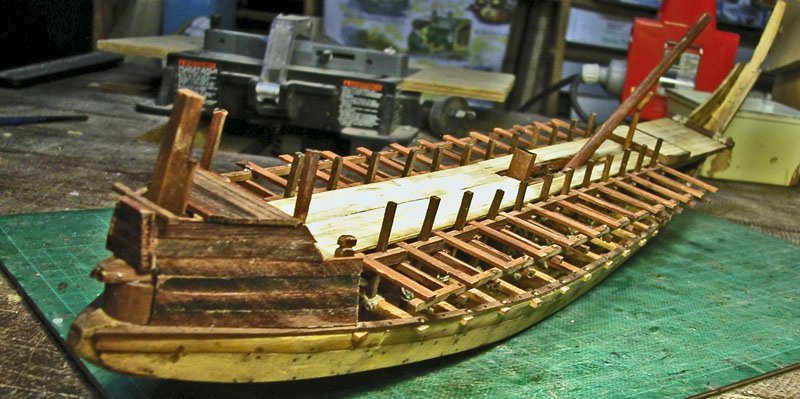
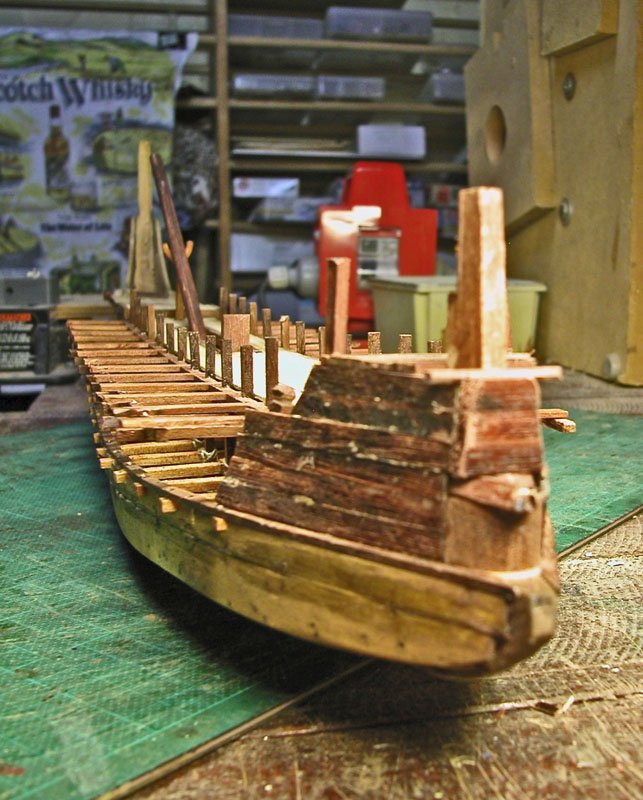
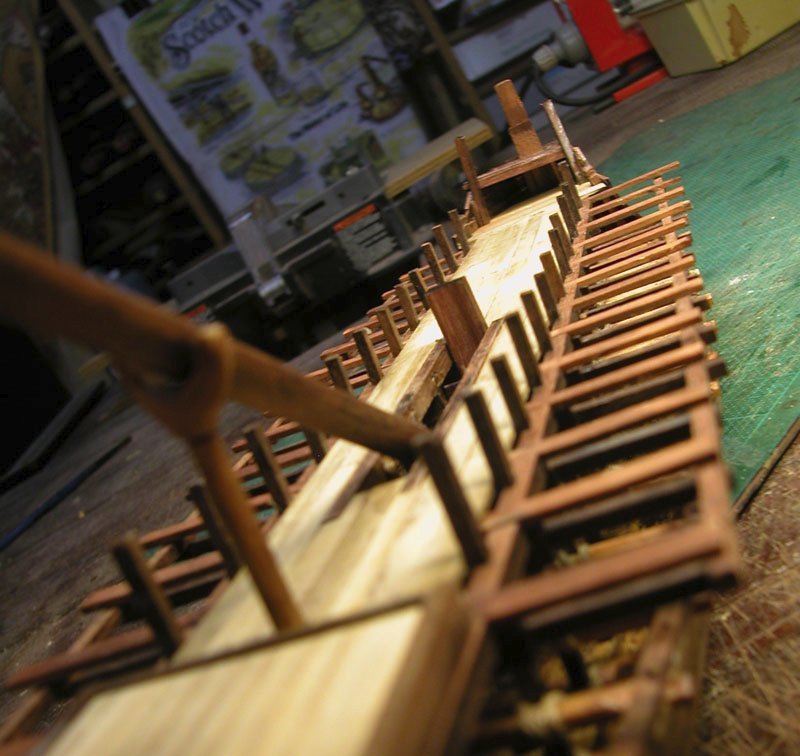
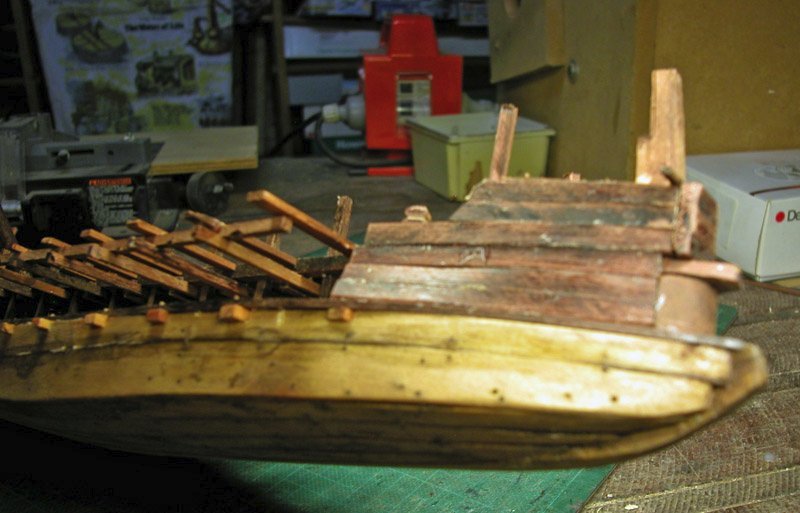
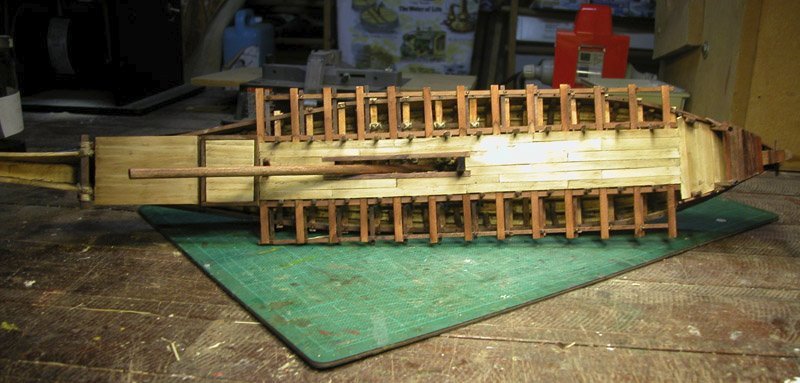
Cheers
Dick
- ccoyle, Roger Pellett, GrandpaPhil and 7 others
-
 8
8
-
 2
2
-
3 hours ago, Ferrus Manus said:
Now that i've thouroughly pissed off Woodrat, we can continue.
Woodrats are slow to anger.
Here are the effects on the hull shape by varying the l/b/ratio. This may help you decide.
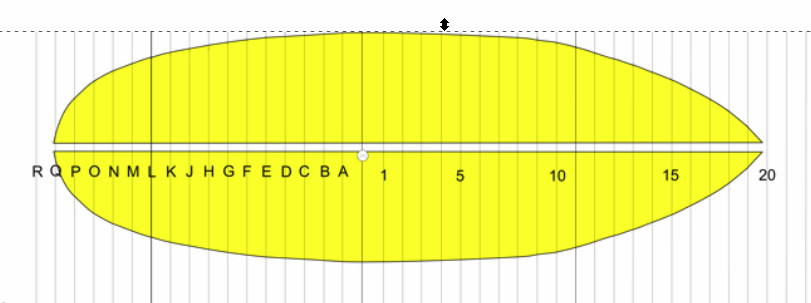 L/B = 2.1
L/B = 2.1
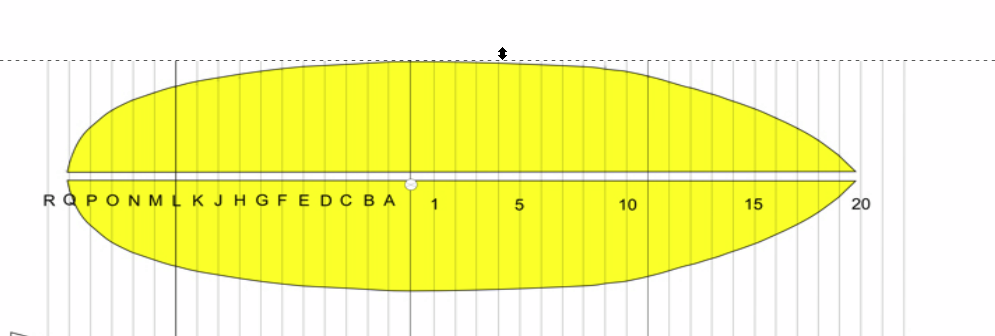 L/b =2.5
L/b =2.5
 l/b = 3
l/b = 3

Cheers
Dick
- mtaylor, botra288, GrandpaPhil and 1 other
-
 4
4
-
3 hours ago, Ferrus Manus said:
Would a total length/total beam ratio of about 2.5 be appropriate?
If you like but this would give a length of keel /breadth of midship frame of about three. You decide.
Dick
- Ferrus Manus and mtaylor
-
 1
1
-
 1
1
-
13 hours ago, Ferrus Manus said:
So the total l/b would be about 3/1?
I dont know what total l/b means! Please use length of keel/breadth of midship frame. It is explicitly documented that fifteenth century carracks or cocha were around 2.5. This I would regard as a logical starting point.
Dick
-
On 4/14/2023 at 3:15 AM, Ferrus Manus said:
Let's assume the lbp/b is 2/1. This would give us a total l/b of approaching 2.5/1.
I would suggest only using length of keel/breadth of midship frame and forget I ever mentioned length between perpendiculars. I still suggest 2.5 as a starting point.
If you are planning POB at large scale, you are going to need at least a jigsaw or a fretsaw and elbow grease and I would suggest good quality plywood. Dont rush in. I spent years collecting and making tools before I cut the first wood for my first scratch build the USF Essex. Use the collective hive mind of the MSW tribe to its full extent.
Dick
-
are you talking of length of keel or length between perpendiculars? It makes a difference. Let us assume it is length of keel. For venetian galleon 16th century Pre Theodoro gives keel length to breadth ratio as about 2.6:1. This would be higher if you use length between perpendiculars. For an english galleon of 16th century length to breadth about 3:1. BUt thise is not likely for a 15th century nao. I imagine spanish would be similar to venetian in most regards.
As far as 15th century practice, have a guess but I would say 3:1 is a tad high and would tend to go for the ratio of 2.5:1 (I base this on the figures given for venetian naves in F C Lanes Venetian Shipbuilders of the Renaissance. There were no set rules and shibbuilders varied.
Dick
-
4 hours ago, mtaylor said:
Dick, the photos didn't come through. Try re-loading them.
Thanks, Mark. Here are the missing pics. The mast is seen lying on its crutch. The upper bank of rowing benches is now added
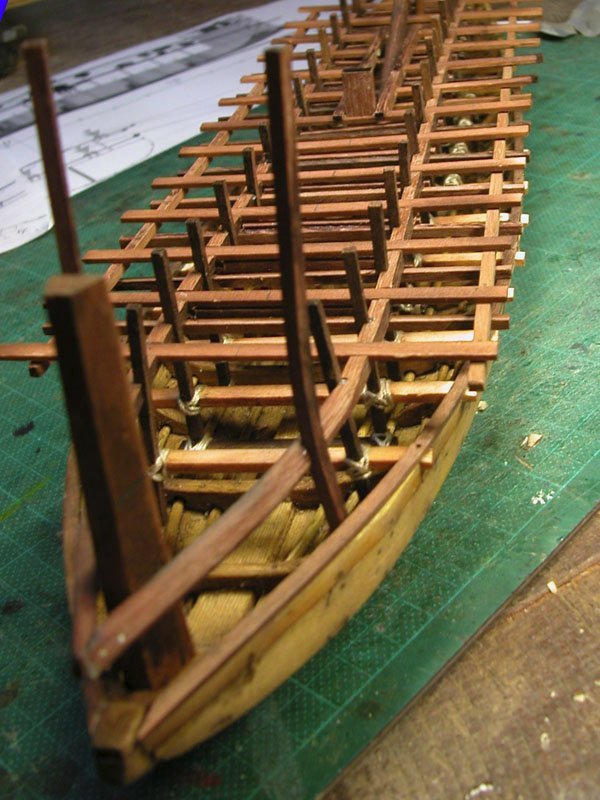
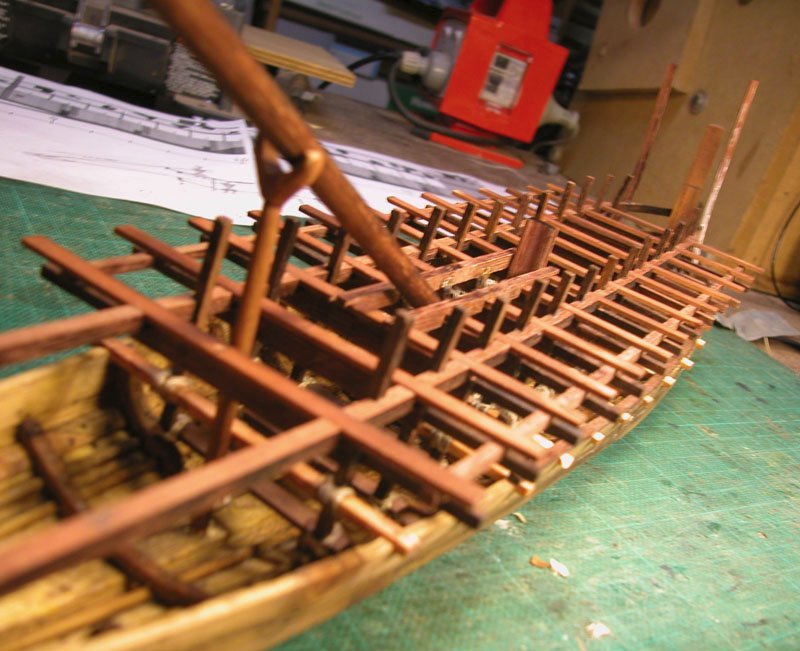
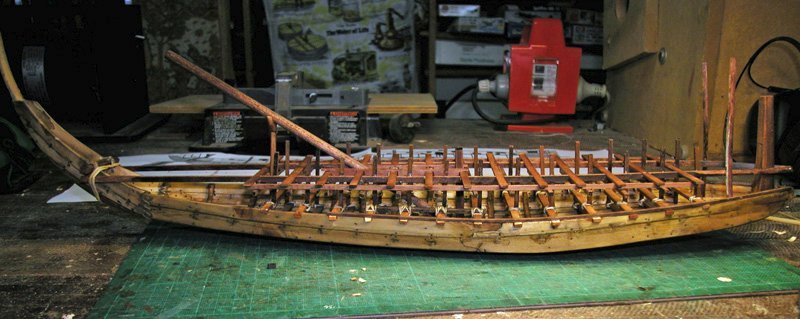
Cheers
Dick
- druxey, GrandpaPhil, Archi and 7 others
-
 10
10
-
I have added the upper bank to the galley. The foot rests can be seen. Note that there will be a cutout in the central deck to allow the mast to be disconnected from the histopede (the upright on the keel plank to which the mast is lashed and to be tilted down onto the crutch (histodoke). The yard could then be furled and stored. The more I think about it the more sense there is in an upper and a lower bank of rowers. It would mean there are two teams which could row in shifts . When a maximum effort is required, both teams could row. When storming a beach , the lower rowers could row onto the beach while the upper team gets into their armour and weapons and prepare to attack or repel boarders



Cheers
Dick
-
There is a basic problem with using the Mataro vessel as the basis for a model in that , although built by someone who had knowledge of contemporary shipbuilding techniques, he was building it for reasons that are foreign to us. This vessel was a votive object. That is to say, it was an object of art made to celebrate a religious event: a salvation, a conversion, or a simply as a form of thanksgiving. Maybe it was even commissioned by the catholic church, who knows? The completed work of art was presumably meant to be hung from the rafters of a church and viewed only from certain angles. It was of supreme disinterest to the builder to accurately depict a scaled down replica of an existing ship (something which obsesses us today but did not start to occur till the seventeenth century). What was required was an object which conveyed to the lay person the idea of "ship" without obsessionally replicating it. Consequently, the dimensions of these votive ships were distorted and unreliable, Such votive "ships" were not uncommon in european churches during the middle ages and, it is my belief, such "models" were copied by artists to depict the vessels of the time. A classic example is the series of depictions of carracks produced by the master WA which were clearly drawn from model ships. You have to wait for the Renaissance artists such as Carpaccio who drew from real ships to reduce the distortions.
So, by all means use the Mataro as a guide but I would suggest that reproducing an"accurate" reproduction of a carrack is largely guesswork. Even the archaeological remains are fragmentary and to some degree distorted but still give the best information on construction techniques.
I'll get out of your way now (homage to John Clarke, sadly missed).
Dick
- botra288, mtaylor and Ferrus Manus
-
 2
2
-
 1
1
-
-
4 hours ago, Louie da fly said:
Despite my having found this photo on a site relating to Maltese vessels, this is flying what looks like a Portuguese flag. But that bow looks very like the one I propose for my San Marco ship.
It looks rather like a bragozzo, which is venetian, although I think they had lug sails.
Dick
-
Yes. You can see some projecting planks on the after part of the hull over which the stern sleeve slides. The sewn ropes are just to hold the stern on and allow disassembly (see Khufu royal barge).
The longitudinal internal stringers are for holding in the caulking .
Dick
- mtaylor and Louie da fly
-
 2
2
-
The stern module has been attached. It is my contention that these war galleys may have been required to be transported over land (see the Gurob ship cart) as was done later in classical times over the isthmus of Corinth. So it would have been advantageous to be able to dissassemble the craft partly. Hence the stern module is designed to slide into place and be held by sewn ropes as was the case with egyptian vessels. Also seen here is the through-beam in the stern upon which the steering oar bore. This also is fixed by ropes.
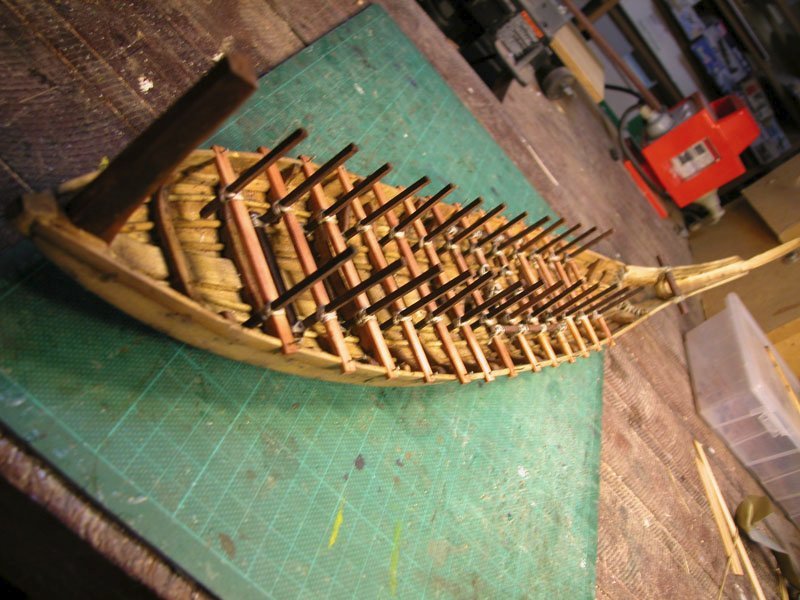
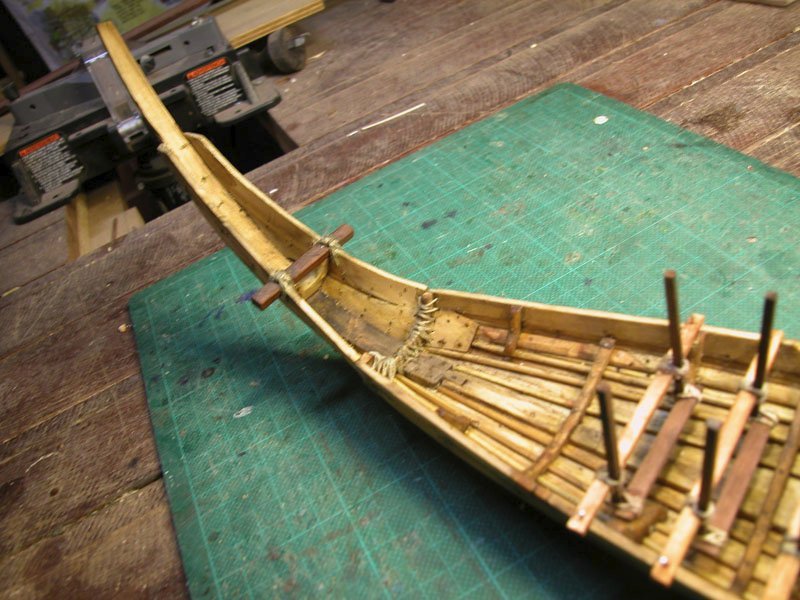
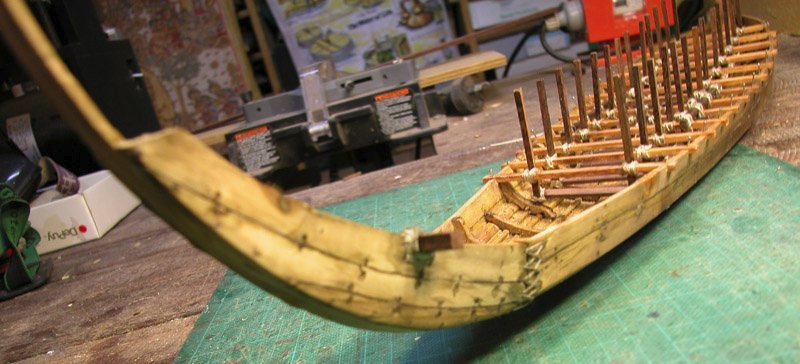
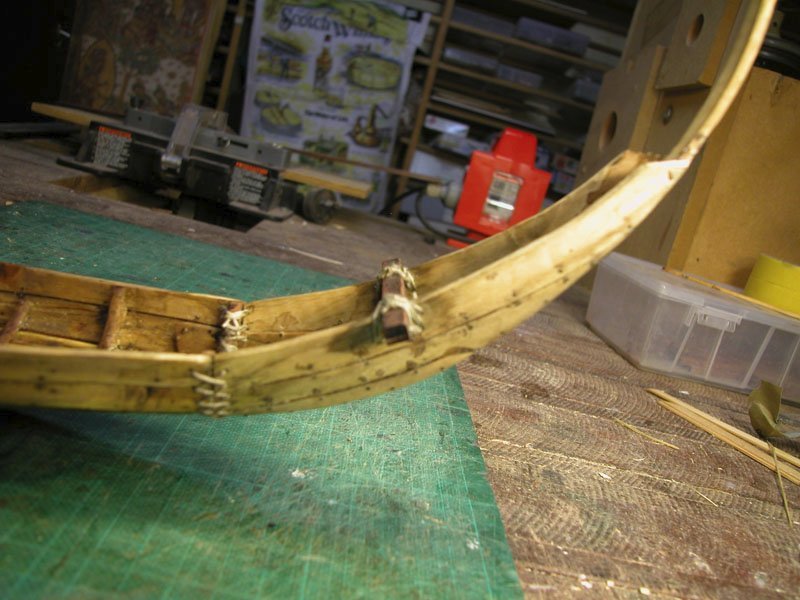
Cheers
Dick
-
This looks like fun to me. Enjoy your new toy
Dick😁
- druxey, mtaylor and Louie da fly
-
 3
3
-
10 hours ago, Snug Harbor Johnny said:
There are some similarities to the Khufu barge, in that there are 'stringers' spaced on the interior, and the bottom is nearly flat
Yes, its absurd to think that the mycenaeans were not aware of egyptian shipbuilding practices and used them. The method of attaching the stern module is also adapted from the Khufu barge. The flat bottom and beaching sled on the bow make bringing the boat ashore much safer.
Dick
- mtaylor and Roger Pellett
-
 2
2
-
Thanks, Steven. I had seen most of these "reconstructions" before but did not want to become influenced by them. As it is, they have reconstructed single banked galleys whereas I wish to produce an idea of how a double banked galley could be built keeping iin mind the materials available in the Bronze age.
I have inserted the lower thwarts and made them integral with the vertical stanchions and the rowers' foot rests. I made a rough jig
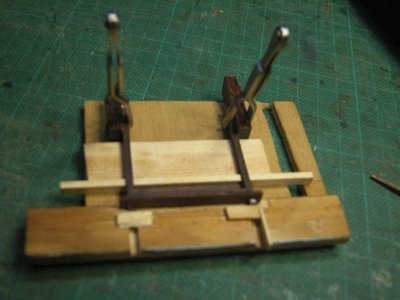 to ensure that all these Frames are uniform as they will be used to construct the upper rowing benches and central walkway
to ensure that all these Frames are uniform as they will be used to construct the upper rowing benches and central walkway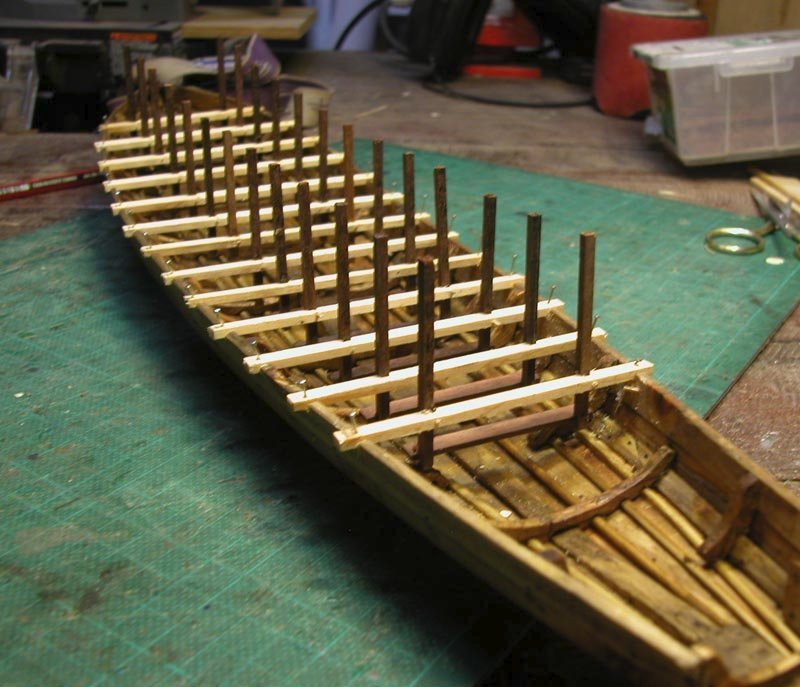
The thwarts and stachions are lashed together as metal nails would not have been used.
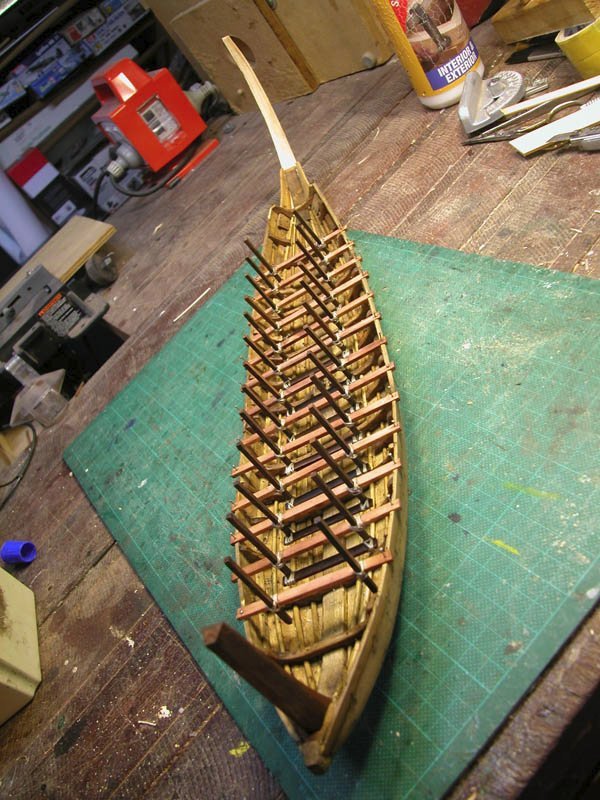
Note the ladder-like appearance produced by the vertical stanchions as seen in the pottery images from the time.
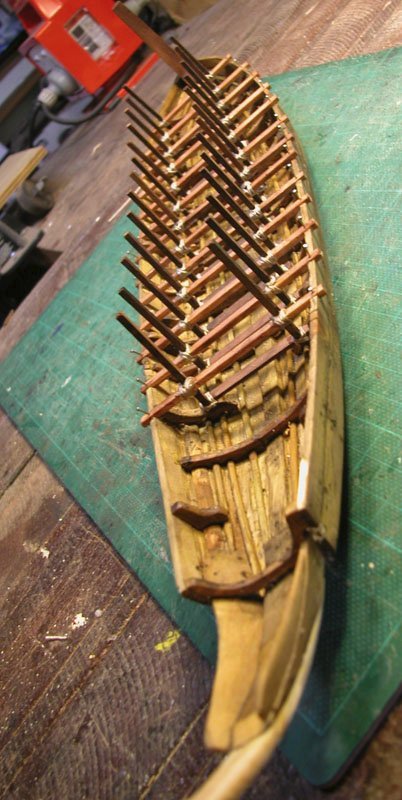
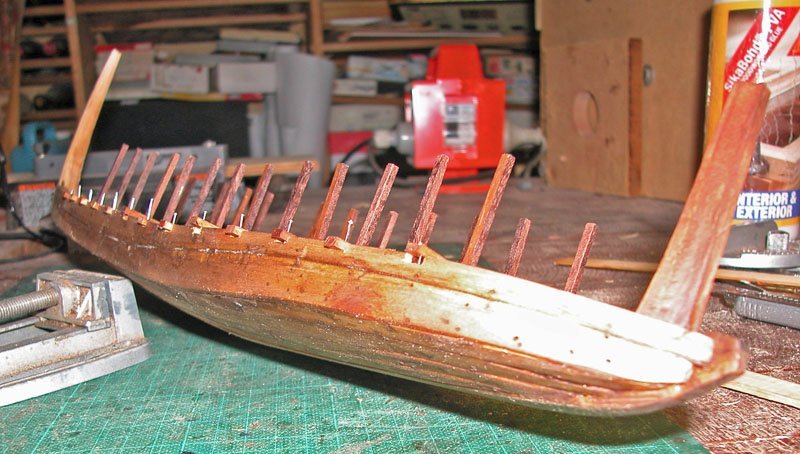
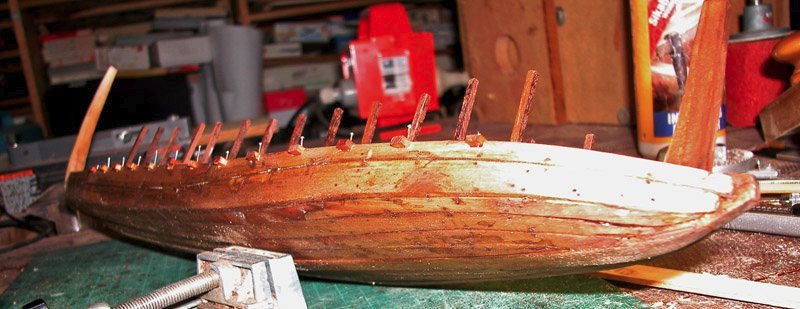
The next step is firstly to make the curved stern and then I will be able to start on the longitudinal "wales" to which the upper benches will be attached
Cheers
Dick
-
The frames and foothooks have been inserted. This gives resistance to twisting, The hull is surprisingly strong even without the frames.
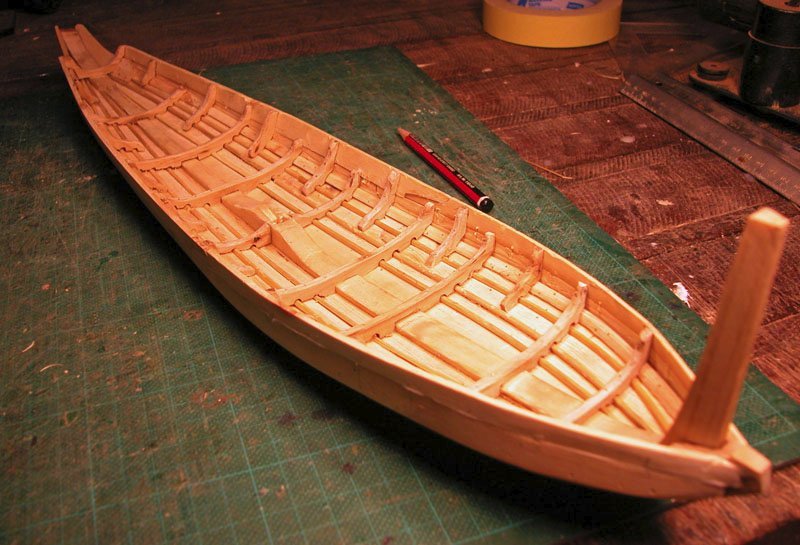
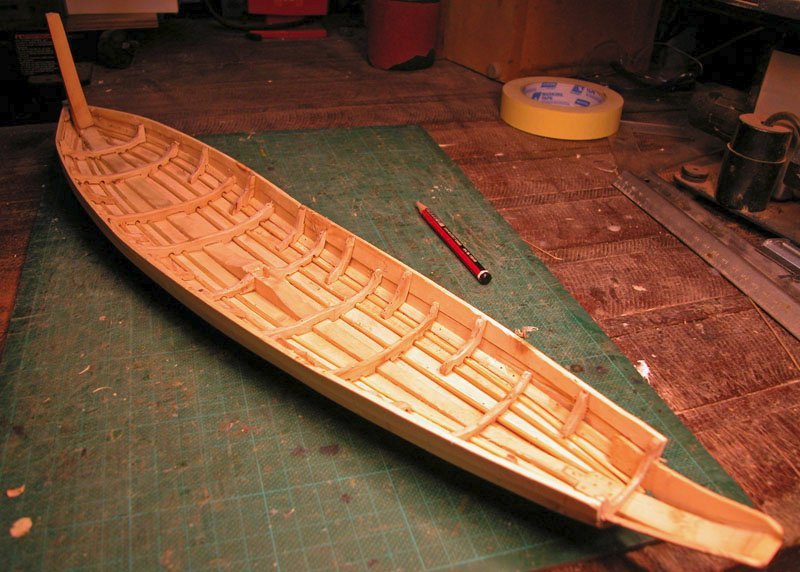
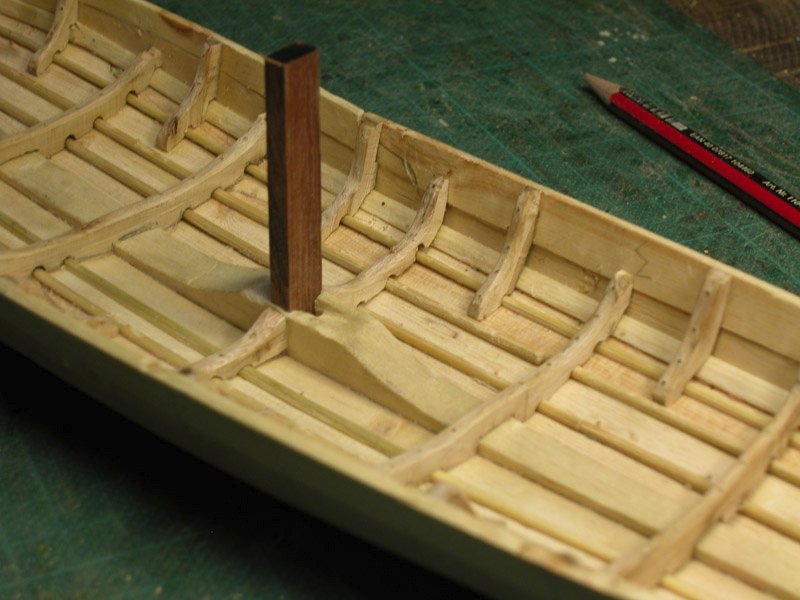 This shows the histopede to which the mast is lashed
This shows the histopede to which the mast is lashed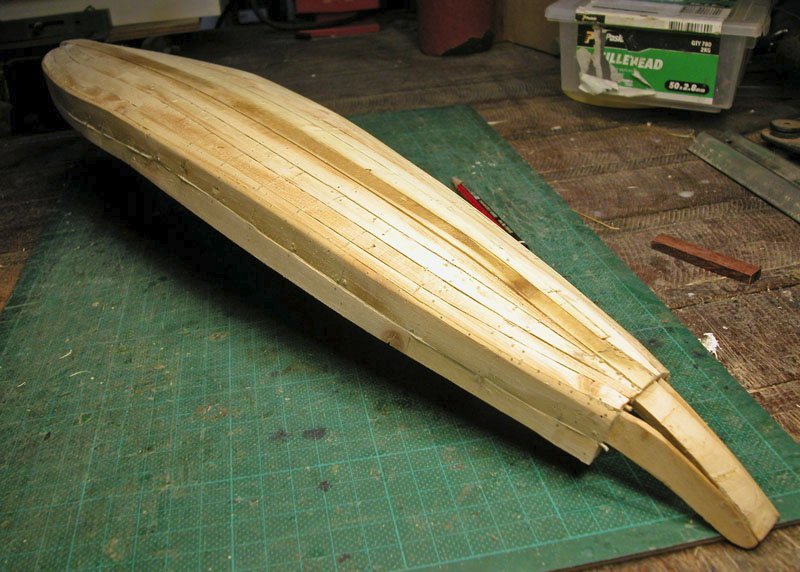
Dick
- Louie da fly, botra288, GrandpaPhil and 5 others
-
 4
4
-
 4
4
-
-
The planking is complete although the caulking remains to be done. Note the construction at the after end which is in preparation for the stern module to be attached like a sleeve. Some reinforcement of the prow was necessary but this is not a true beak (which came later during the geometric period or Iron Age (maybe worth another model?).
Dick
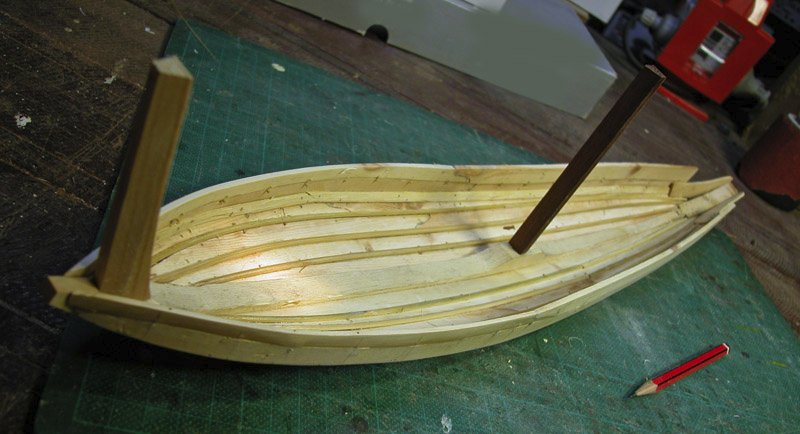
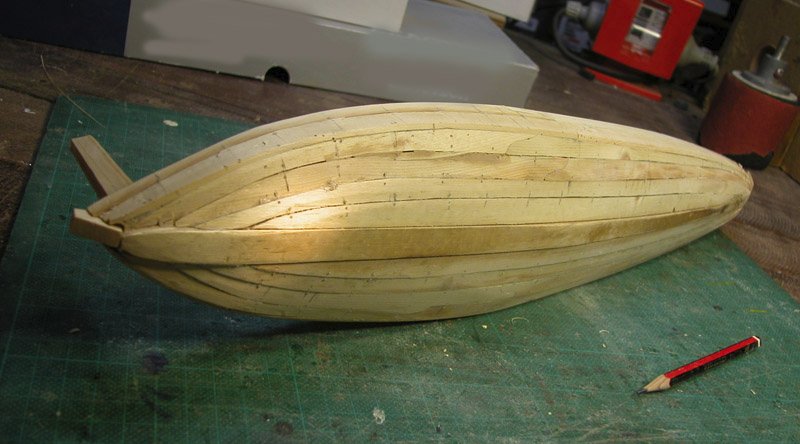
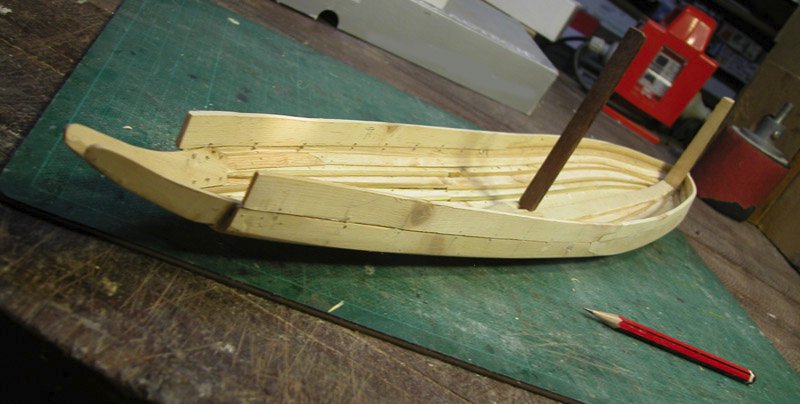
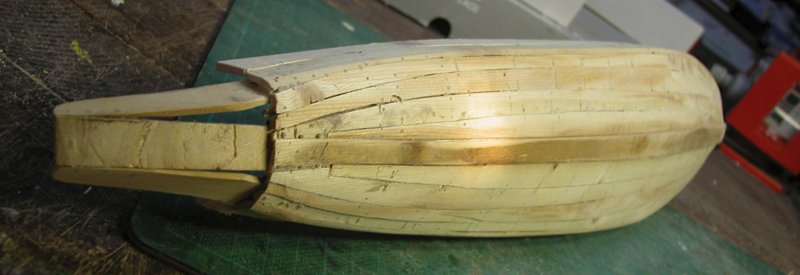


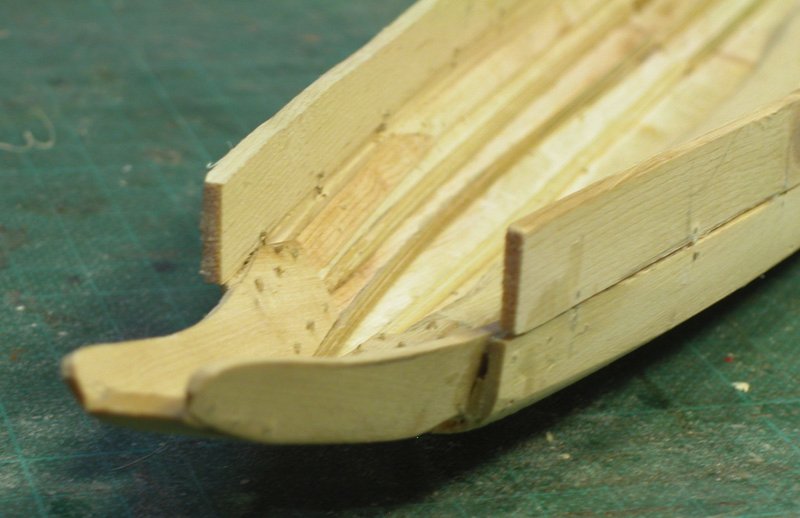
- Prowler901, Roger Pellett, ccoyle and 6 others
-
 7
7
-
 2
2


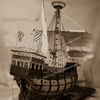
Mycenaean War Galley by Woodrat - FINISHED - 1:48 - Shell first Plank on Frame
in - Subjects built Up to and including 1500 AD
Posted
I opine that the eyes on the Duck are the eyes of the god. The oculi on the bow are the eyes of the boat. How else could it see where to go? You wouldn't trust a duck!
Dick